1995 CHEVROLET S10 wheel
[x] Cancel search: wheelPage 16 of 354
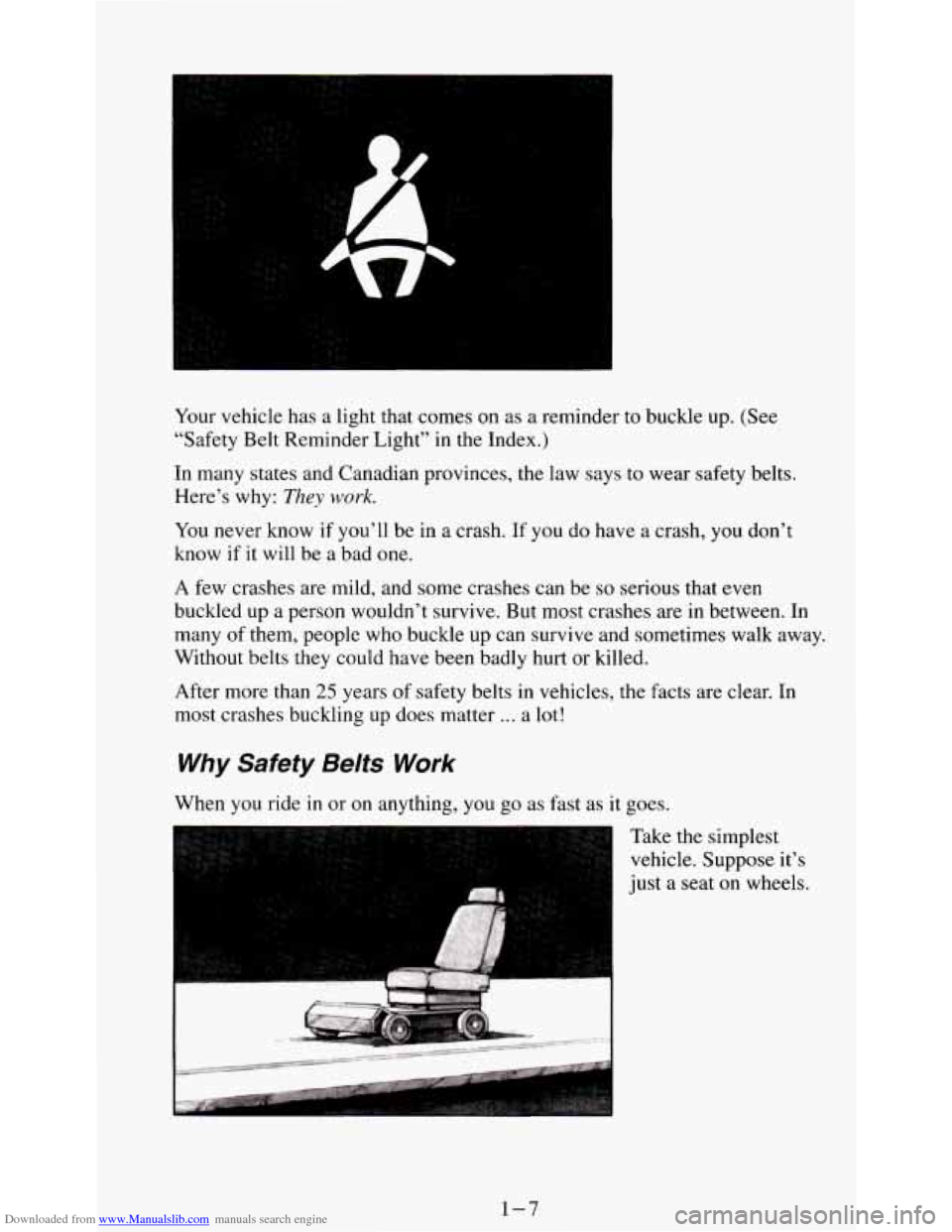
Downloaded from www.Manualslib.com manuals search engine Your vehicle has a light that comes on as a reminder to buckle up. (See
“Safety Belt Reminder Light” in the Index.)
In many states and Canadian provinces, the law says to wear safety belts.
Here’s why:
They work.
You never know if you’ll be in a crash. If you do have a crash, you don’t
know
if it will be a bad one.
A few crashes are mild, and some crashes can be so serious that even
buckled up a person wouldn’t survive. But most crashes are in between. In
many of them, people who buckle up can survive and sometimes walk away.
Without belts they could have been badly hurt or killed.
After more than
25 years of safety belts in vehicles, the facts are clear. In
most crashes buckling up does matter
... a lot!
Why Safety Belts Work
When you ride in or on anything, you go as fast as it goes.
Take the simplest
vehicle. Suppose it’s
just a seat on wheels.
1-7
Page 26 of 354
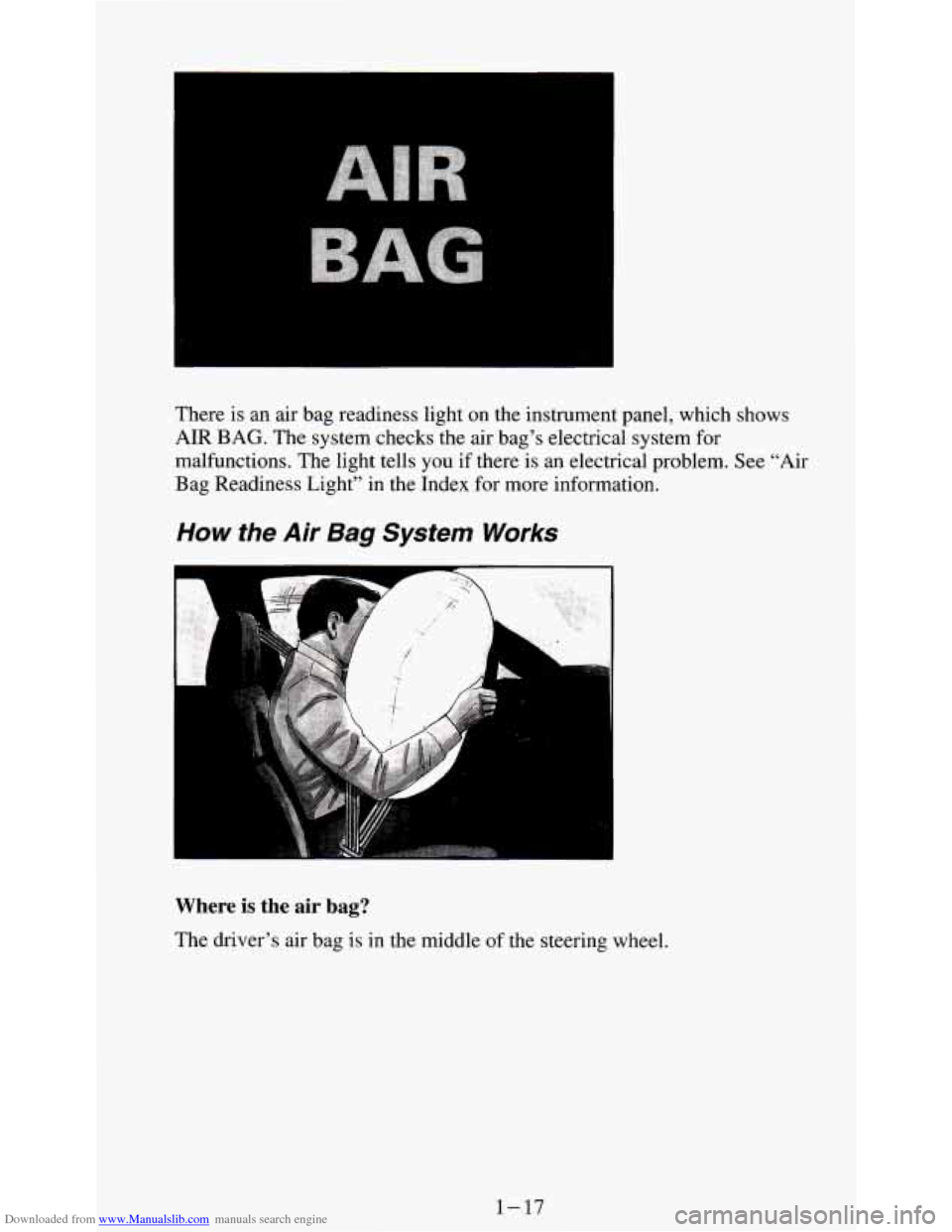
Downloaded from www.Manualslib.com manuals search engine There is an air bag readiness light on the instrument panel, which shows
AIR BAG. The system checks the air bag’s electrical system for
malfunctions. The light tells
you if there is an electrical problem. See “Air
Bag Readiness Light” in the Index for more information.
How the Air Bag System Works
Where is the air bag?
The driver’s air bag is in the middle of the steering wheel.
1-17
Page 27 of 354
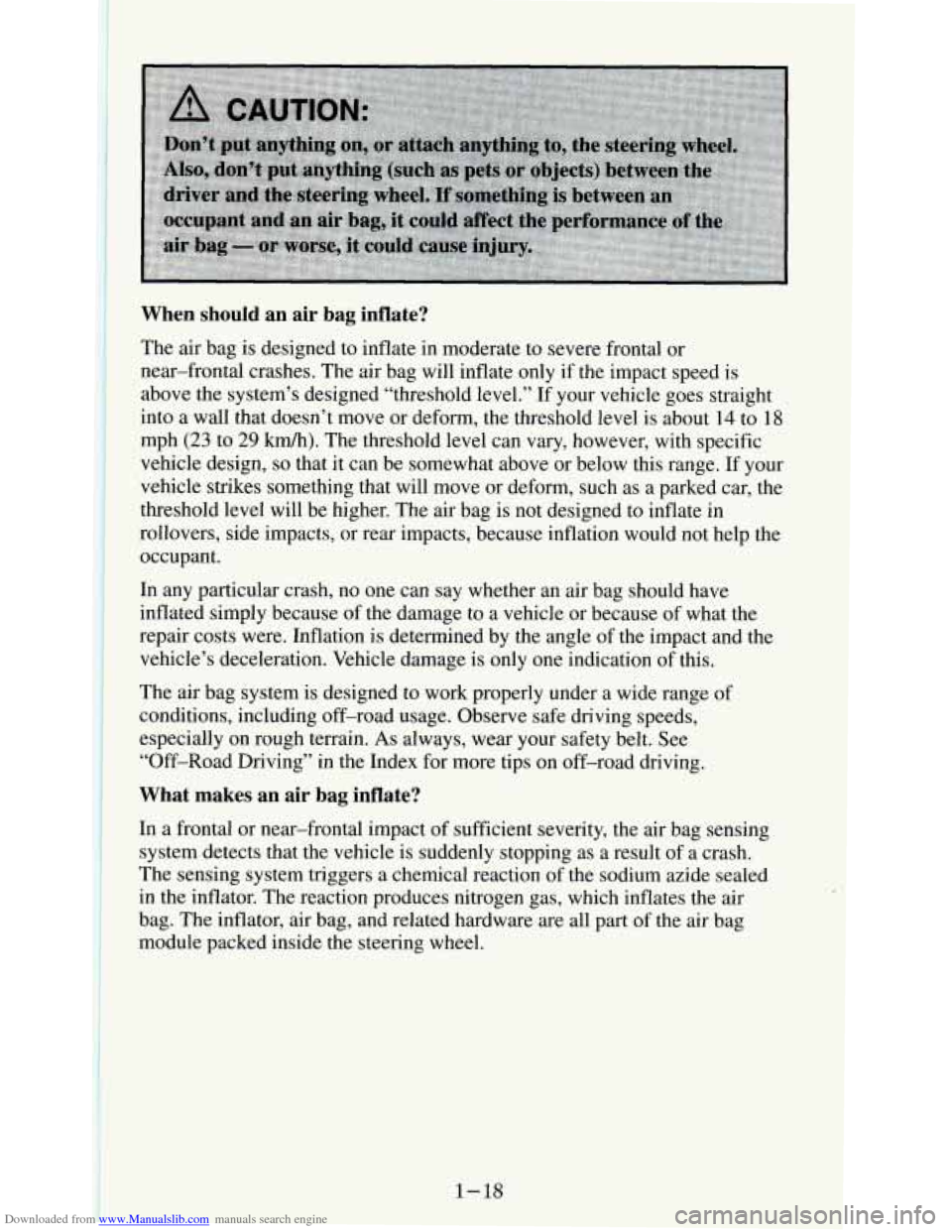
Downloaded from www.Manualslib.com manuals search engine When should an air bag inflate?
The air bag is designed to inflate in moderate to severe frontal or
near-frontal crashes. The air bag will inflate only if the impact speed is
above the system’s designed “threshold level.” If your vehicle\
goes straight
into a wall that doesn’t move or deform, the threshold level is about 14 to
18
mph (23 to 29 kdh). The threshold level can vary, however, with specific
vehicle design,
so that it can be somewhat above or below this range. If your
vehicle strikes something that will move or deform, such
as a parked car, the
threshold level will be higher. The air bag is not designed to inflate in
rollovers, side impacts, or rear impacts, because inflation would not help the
occupant.
In any particular crash, no one can say whether an air bag should have
inflated simply because
of the damage to a vehicle or because of what the
repair costs were. Inflation is determined by the angle of the impact and the
vehicle’s deceleration. Vehicle damage is only one indication of this.
The air bag system is designed to work properly under a wide range of
conditions, including off-road usage. Observe safe driving speeds,
especially on rough terrain.
As always, wear your safety belt. See
“Off-Road Driving” in the Index for more tips on off-road driving.
What makes an air bag inflate?
In a frontal or near-frontal impact of sufficient severity, the air bag sensing
system detects that the vehicle is suddenly stopping as a result of a crash.
The sensing system triggers a chemical reaction
of the sodium azide sealed
in the inflator. The reaction produces nitrogen gas, which inflates the air
bag. The inflator, air bag, and related hardware are all part
of the air bag
module packed inside the steering wheel.
1-18
Page 28 of 354
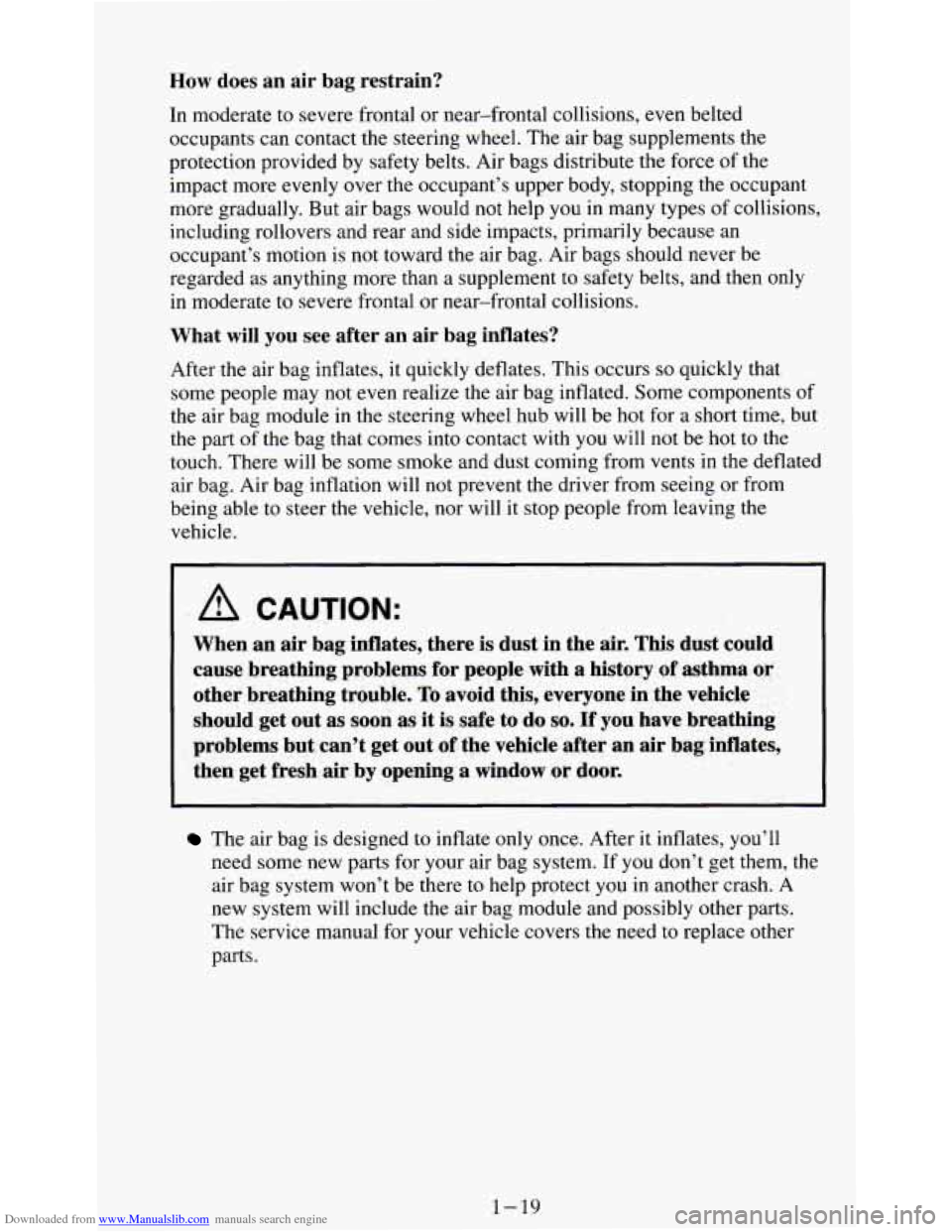
Downloaded from www.Manualslib.com manuals search engine How does an air bag restrain?
In moderate to severe frontal or near-frontal collisions, even belted
occupants can contact the steering wheel. The air bag supplements the
protection provided by safety belts. Air bags distribute the force of the
impact more evenly over the occupant’s upper body, stopping the occupant
more gradually. But air bags would
not help you in many types of collisions,
including rollovers and rear and side impacts, primarily because an
occupant’s motion is not toward the air bag. Air bags should never be
regarded as anything more than a supplement
to safety belts, and then only
in moderate to severe frontal or near-frontal collisions.
What will you see after an air bag inflates?
After the air bag inflates, it quickly deflates. This occurs so quickly that
some people may not even realize the air bag inflated. Some components
of
the air bag module in the steering wheel hub will be hot for a short time, but
the part
of the bag that comes into contact with you will not be hot to the
touch. There will be some smoke and dust coming from vents in the deflated
air bag. Air bag inflation will not prevent
the driver from seeing or from
being able
to steer the vehicle, nor will it stop people from leaving the
vehicle.
A CAUTION:
When an air bag inflates, there is dust in the air. This dust could
cause breathing problems for people with a history
of asthma or
other breathing trouble. To avoid this, everyone in the vehicle
should get out as soon as it is safe to do
so. If you have breathing
problems but can’t get out
of the vehicle after an air bag inflates,
then get fresh air by opening a window or door.
The air bag is designed to inflate only once. After it inflates, you’ll
need some new parts for your air bag system. If you don’t get them, the
air bag system won’t be there to help protect you in another crash. A
new system will include the air bag module and possibly other parts.
The service manual for your vehicle covers the need to replace other
parts.
1-19
Page 53 of 354
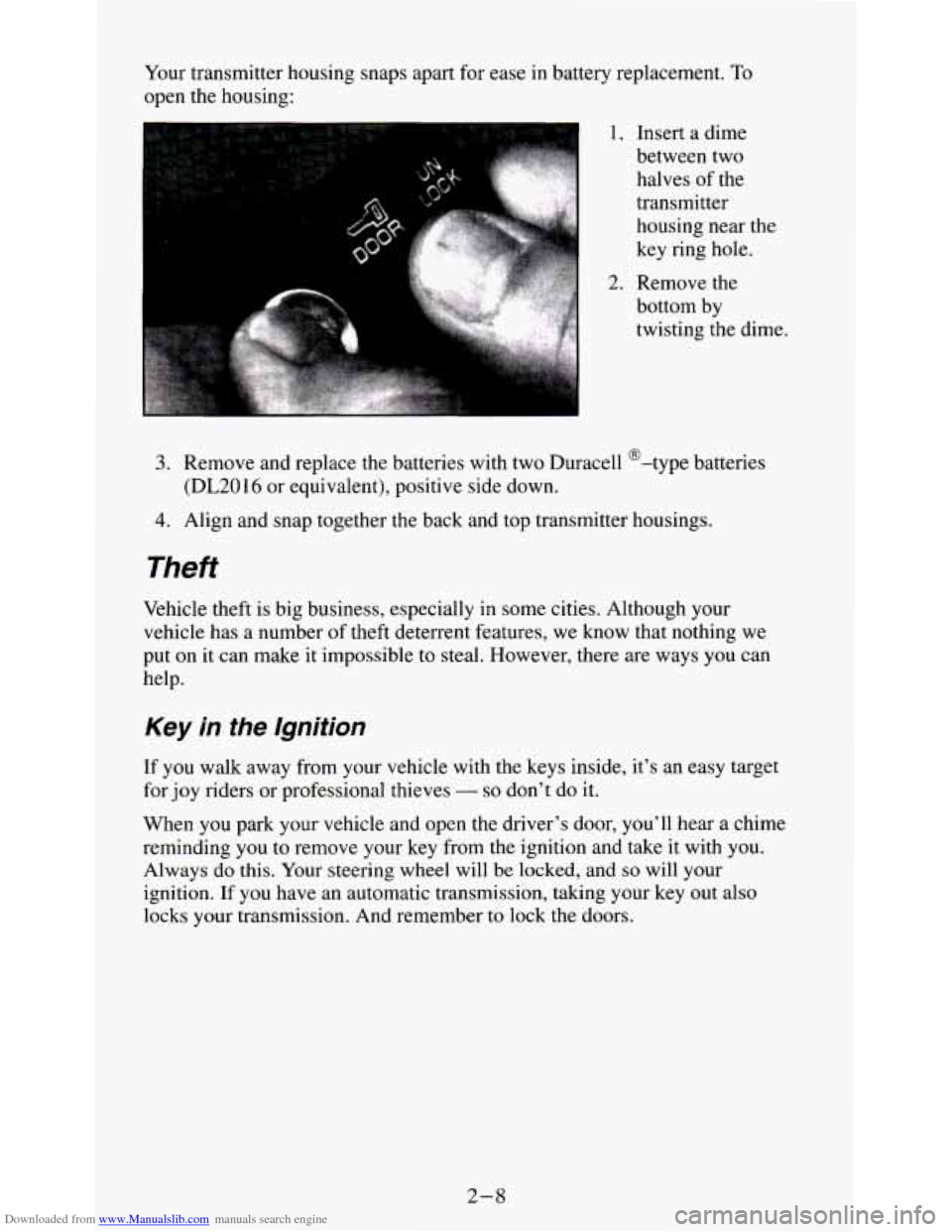
Downloaded from www.Manualslib.com manuals search engine Your transmitter housing snaps apart for ease in battery replacement. To
open the housing:
1. Insert a dime
between two
halves
of the
transmitter
housing near the
key ring hole.
2. Remove the
bottom by
twisting the dime.
3. Remove and replace the batteries with two Duracell @-type batteries
4. Align and snap together the back and top transmitter housings.
(DL2016
or equivalent), positive side down.
Theft
Vehicle theft is big business, especially in some cities. Although your
vehicle has a number
of theft deterrent features, we know that nothing we
put
on it can make it impossible to steal. However, there are ways you can
help.
Key in the lgnition
If you walk away from your vehicle with the keys inside, it’s an easy target
for joy riders or professional thieves
- so don’t do it.
When
you park your vehicle and open the driver’s door, you’ll hear a chime
reminding you
to remove your key from the ignition and take it with you.
Always do this. Your steering wheel will be locked, and so will your
ignition.
If you have an automatic transmission, taking your key out also
locks your transmission. And remember
to lock the doors.
2-8
Page 55 of 354
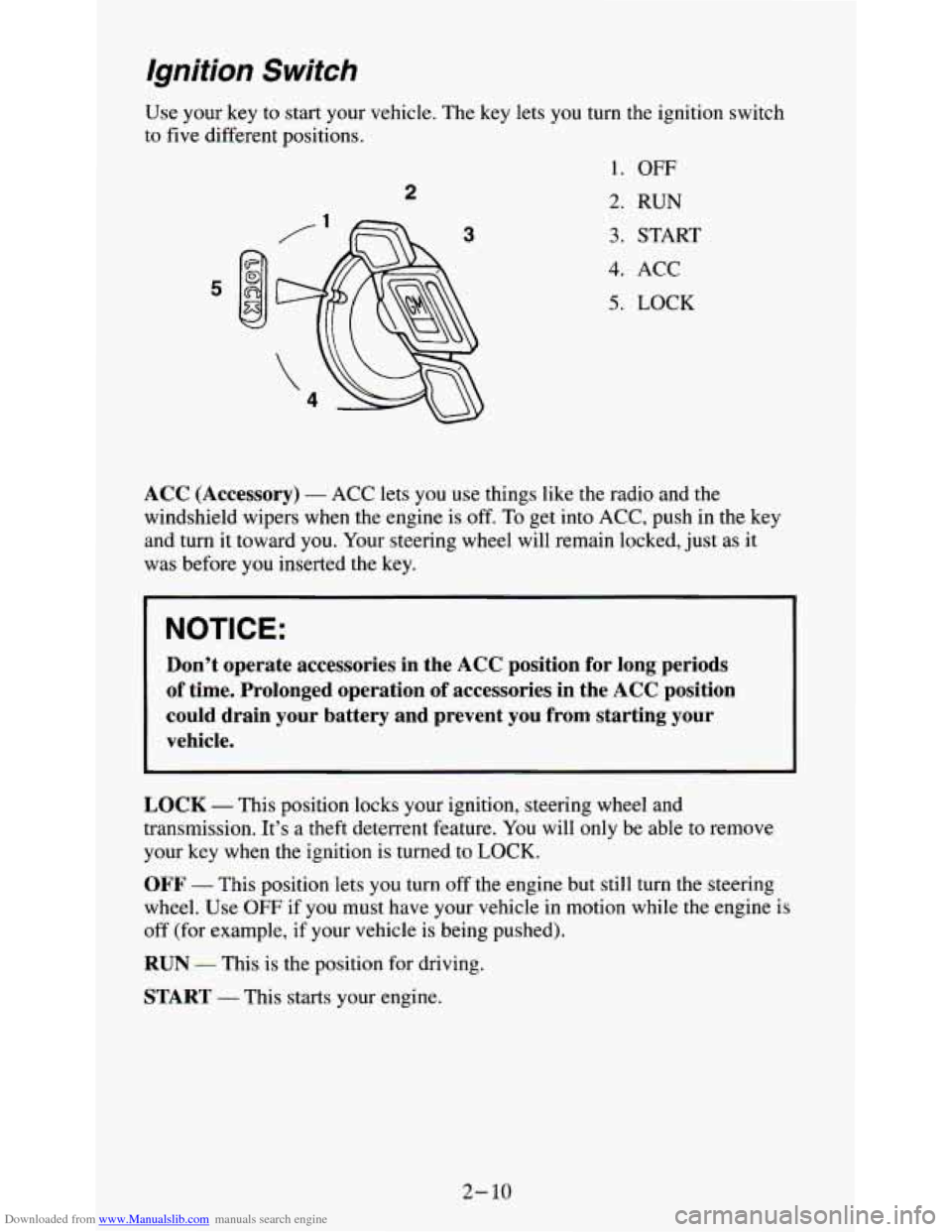
Downloaded from www.Manualslib.com manuals search engine Ignition Switch
2
Use your key to start your vehicle. The key lets you turn the ignition switch
to five different positions.
1.
OFF
2. RUN
3. START
4. ACC
5. LOCK 5
ACC (Accessory) - ACC lets you use things like the radio and the
windshield wipers when the engine is off. To get into ACC, push in the key
and turn it toward
you. Your steering wheel will remain locked, just as it
was before you inserted the key.
Don’t operate accessories in the ACC position for long periods
of time. Prolonged operation
of accessories in the ACC position
could drain your battery and prevent you from starting your
vehicle.
LOCK - This position locks your ignition, steering wheel and
transmission. It’s a theft deterrent feature. You will only
be able to remove
your key when
the ignition is turned to LOCK.
OFF - This position lets you turn off the engine but still turn the steering
wheel. Use
OFF if you must have your vehicle in motion while the engine is
off (for example, if your vehicle
is being pushed).
RUN - This is the position for driving.
START - This starts your engine.
2- 10
Page 56 of 354
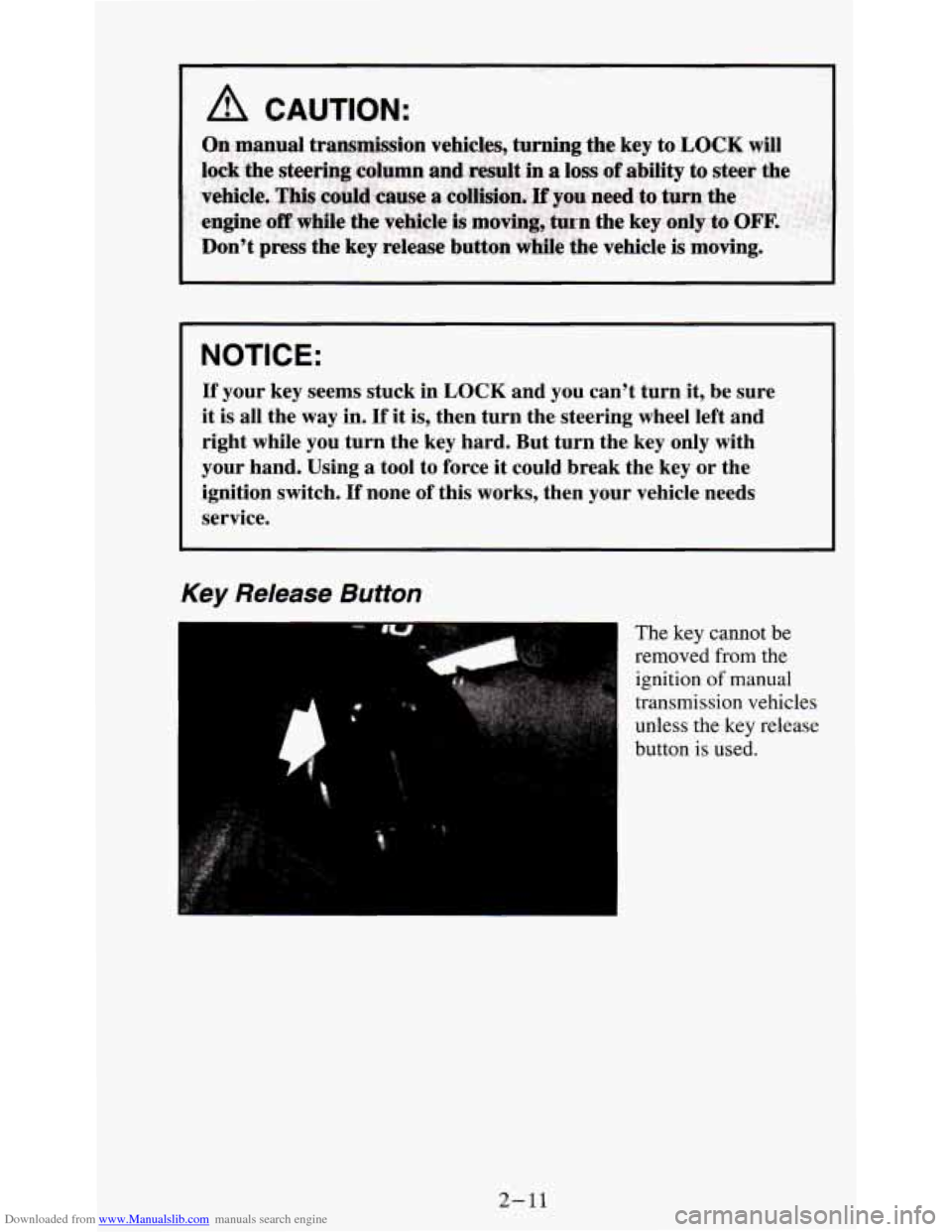
Downloaded from www.Manualslib.com manuals search engine I NOTICE:
If your key seems stuck in LOCK and you can’t turn it, be sure
it is all the way in. If it is, then turn the steering wheel left and
right while you turn the key hard. But turn the key only with
your hand. Using a tool to force it could break the key or the
ignition switch.
If none of this works, then your vehicle needs
service.
Key Release Button
The key cannot be
removed
from the
ignition
of manual
transmission vehicles
unless the
key release
button
is used.
2-11
Page 62 of 354
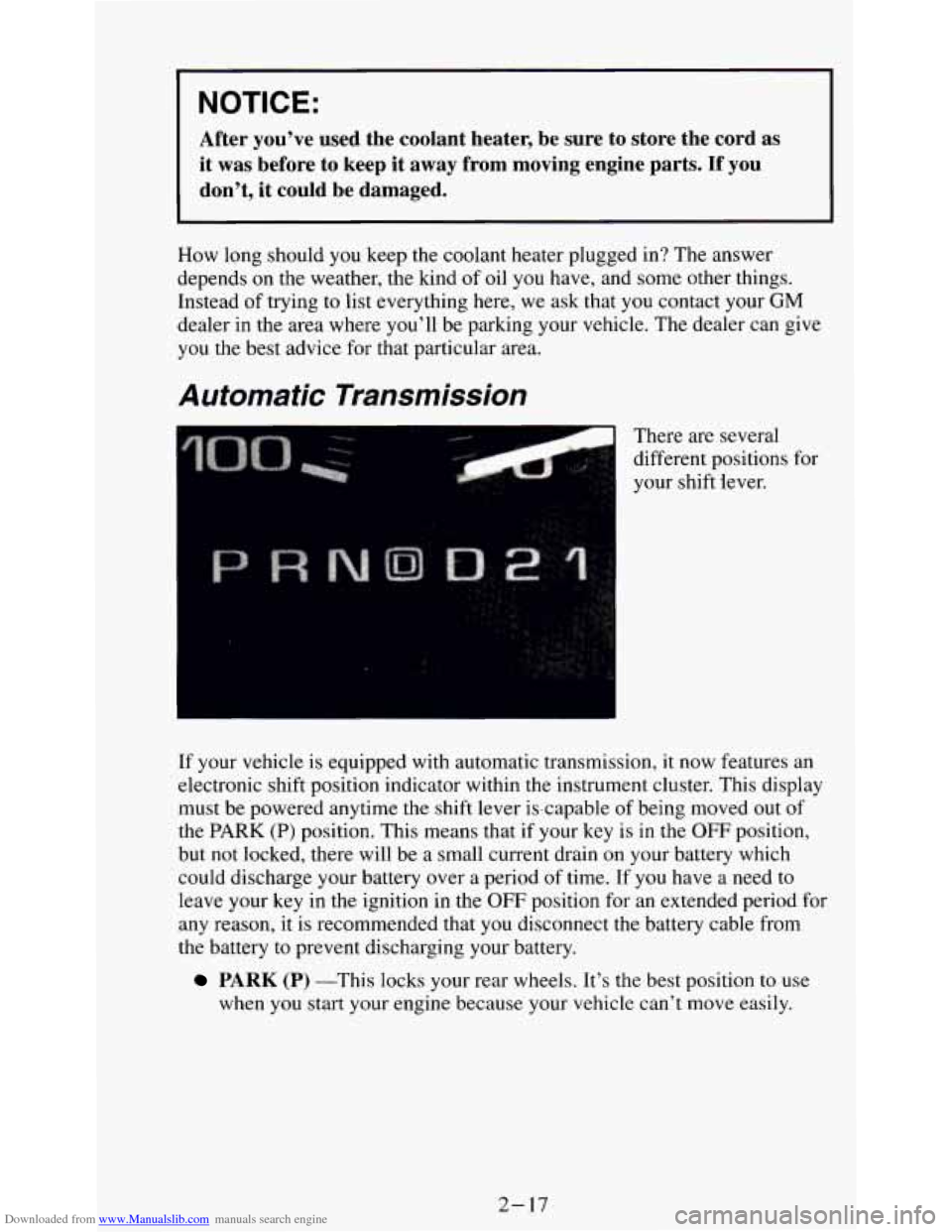
Downloaded from www.Manualslib.com manuals search engine I NOTICE:
After you’ve used the coolant heater, be sure to store the \
cord as
it
was before to keep it away from moving engine parts. If you
don’t, it could be damaged.
How long should you keep the coolant heater plugged in? The answer
depends
on the weather, the kind of oil you have, and some other things.
Instead of trying to list everything here, we ask that
you contact your GM
dealer in the area where you’ll be parking your vehicle. The dealer can give
you the best advice for that particular area.
Automatic Transmission
There are several
different positions for
I
your shift lever.
If your vehicle
is equipped with automatic transmission, it now features an
electronic shift position indicator within
the instrument cluster. This display
must be powered anytime the shift lever is-capable
of being moved out of
the
PARK (P) position. This means that if your key is in the OFF position,
but
not locked, there will be a small current drain on your battery which
could discharge your battery over a period of time. If you have
a need to
leave your key in the ignition in
the OFF position for an extended period for
any reason, it is recommended that you disconnect the battery cable from
the battery
to prevent discharging your battery.
PARK (P) -This locks your rear wheels. It’s the best position to use
when
you start your engine because your vehicle can’t move easily.
2-17